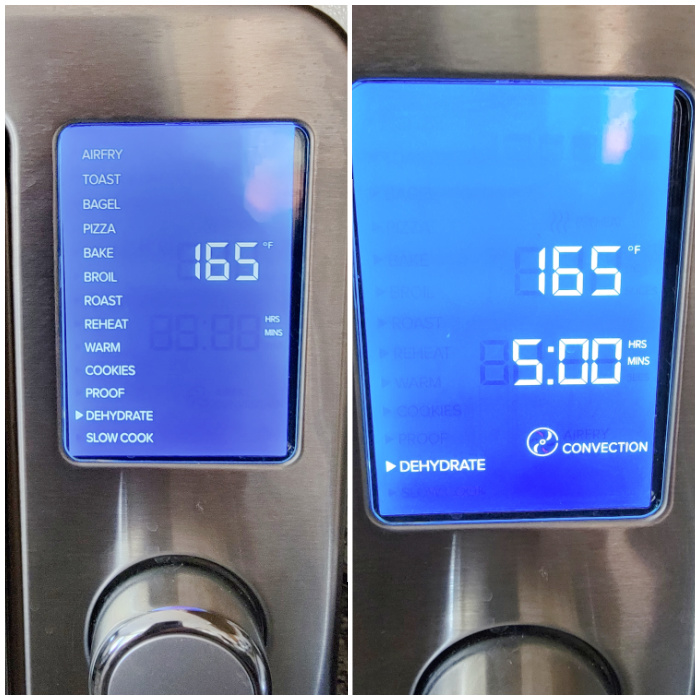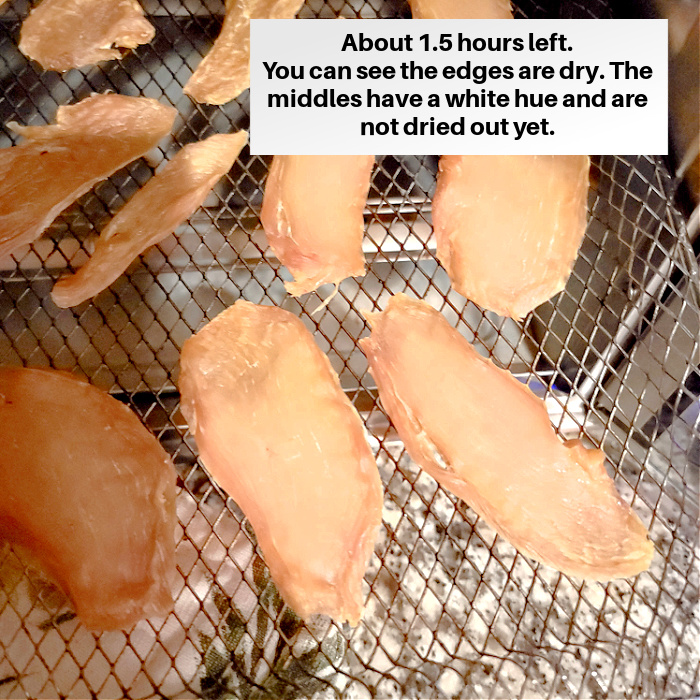Save money and learn how to make dehydrated chicken dog treats at home!
If you’ve been following along, you’ll know that I wrote a post about Our Great Pyrenees Experience with Yuki, the new family puppy. In that post, I talked about how much money feeding a big dog can cost…cha-ching!
Disclaimer: As with any homemade dog treats, make sure it’s safe for your pet by checking with your vet. All dogs have different dietary needs and restrictions.
To help cut the cost of feeding our big pup, I decided to start making homemade dog treats. Some of our pup’s favorite snacks are Baked Honey Cinnamon Dog Treats, frozen treats, and dehydrated chicken. And if you have a dog, you know that dried chicken and chicken jerky can cost A LOT of moolah. A puny 6-ounce bag of dehydrated chicken can cost $8.99 or more, which is kind of crazy since it only costs a few dollars more for an entire pound of fresh organic chicken breasts. So, it only made sense to make homemade dehydrated chicken dog treats and save!
What Cut of Chicken?
- A high-fat diet isn’t the best for dogs as it can cause pancreatitis and diarrhea in some dogs. [1] So it’s better to use chicken breasts, which are leaner than chicken thighs.
- It’s also a good idea to cut off any fat on the chicken breasts, as this can go rancid, even after drying.
- Take a look at the chicken ingredients. Some frozen chicken bags have added salts and chicken broth, which isn’t bad if given in small amounts. If you want to control the amount of added ingredients, stick to organic chicken with no additives.
What Kind of Dehydrator?
As of July 2019, the USDA (United States Department of Agriculture), recommends all meat be cooked to a temperature of 160°F and all poultry to 165°F, BEFORE the dehydrating process. This ensures any bacteria will be killed. Unfortunately, many dehydrators do not reach high enough temperatures to destroy harmful bacteria. Once the meat is heated to safe temperatures, it’s important to maintain a constant dehydrator temperature of 130 to 140°F. This will ensure any water is quickly removed and prevents the growth of microorganisms during the drying process.
- Choose a dehydrator that can maintain steady temperatures of at least 130°F (as recommended by USDA), but preferably higher. If you can find a dehydrator that reaches 165°F or more, that’s even better! Remember, if using a regular dehydrator, the chicken should be cooked till the internal temperature reaches 165°F BEFORE dehydrating.
- Use the dehydrator function on a Multi-Use Air Fryer Oven. These ovens will often let you choose and set the temperature to meet the USDA recommendations. Instead of a regular dehydrator, I now use our Gourmia Multi-function Digital French Door Air Fryer Oven (fromTarget). I noticed that using my multi-use air fryer dries out the chicken much faster than my regular dehydrator and I can skip cooking the chicken before dehydrating because I can set the temperature to 165°F to bake and dehydrate. The downside to using these multi-use ovens is that there is usually only one tray for dehydrating. FYI – this tray will fit exactly one chicken breast.
- If you don’t have a dehydrator, you can always use an oven set at 275°F for several hours. Most chicken slices that are cut to 1/4″ thick will dry in about 3 hours.
How to Store Dehydrated Chicken
- First and foremost, make sure the dehydrated chicken is fully cooled before storing. Any type of heat can cause condensation and will cause spoilage.
- Dehydrated chicken can be kept in airtight containers on the counter for up to 2 weeks. If making a large batch of dehydrated chicken, store in the freezer or refrigerator (up to a year) in an airtight container. [2] I honestly have never made a batch that lasted longer than a few weeks and prefer to store dehydrated chicken in an airtight container in the fridge.
How to Make Dehydrated Chicken Dog Treats?
Okay, it’s time to learn how to make dehydrated chicken dog treats! It’s super simple and easier than you think. FYI – I don’t put any seasonings to the chicken, but it’s up to you if you want to add peanut butter or seasonings on top of the chicken strips.
Before slicing the chicken breast into strips, cut off any large pieces of fat. Next, cut the chicken breasts into 1/4″ thick strips. Cut across the grain for non-aggressive or small dogs. Cut with the grain for aggressive chewers or large dogs.
Tip: If using fresh chicken breasts, place them in the freezer for about 1 – 1 1/2 hours to make them partially frozen. This will make it easier to slice the chicken into strips. If starting with frozen chicken, don’t fully defrost and slice while partially frozen.
Once the chicken is sliced, cut off any excess fat on the chicken strips. If too much fat is left on, it can cause the dehydrated chicken to go rancid quicker.
Place sliced chicken strips onto the dehydrator rack(s). I use my multi-function Gourmia air fryer and set the temperature to 165°F. Then, let the chicken dehydrate for 5-6 hours or until the chicken strips are fully dried out.
Once the chicken strips are fully dehydrated, let them completely cool before storing them in an airtight container.
Store in an airtight container on the counter for up to 2 weeks or the refrigerator (I prefer the fridge). Excess dehydrated chicken that can’t be eaten within 2 weeks should be placed in the freezer.
Our Great Pyrenees, Yuki, LOVES homemade dehydrated chicken treats and I’m sure your dog will too!
Will you try dehydrating chicken breasts for your dog?
References [1] The Skinny on Fat: Part 1 – The Basics petfoodology.com Retrieved May 16,2022 [2] How to Preserve Dehydrated Meat livestrong.com Retrieved May 16,2022
















I have the same toaster oven as you. I have small dogs and did smaller pieces. They stuck to my basket and were extremely hard to remove. Did I not go long enough or too long?
I understand. The way this basket is made, if little pieces of chicken get under the woven wires, they will stick. I tend to keep my pieces larger. I suggest you keep them larger and cut them after they have been dried.
HI I followed your instruction on the dehydrating the chicken jerky my question is how do you preserve the crispness of the jerky? mine came out crispy but after 6 to 7 hours the jerky became so soft the crispness is gone. Any pointers will help Thanks
I’ve never had this issue. You might want to try to dehydrate your chicken longer to make sure all the water has been removed.